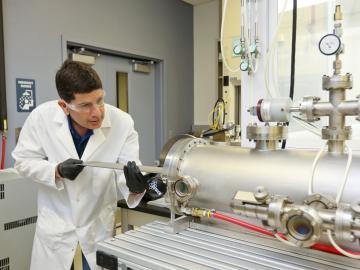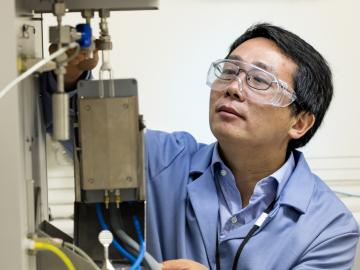
Filter News
Area of Research
- (-) Materials (95)
- (-) Supercomputing (62)
- Advanced Manufacturing (4)
- Biological Systems (2)
- Biology and Environment (56)
- Biology and Soft Matter (1)
- Building Technologies (4)
- Clean Energy (97)
- Climate and Environmental Systems (2)
- Computational Biology (2)
- Computer Science (1)
- Electricity and Smart Grid (1)
- Energy Frontier Research Centers (1)
- Fossil Energy (1)
- Fuel Cycle Science and Technology (1)
- Functional Materials for Energy (2)
- Fusion and Fission (15)
- Fusion Energy (1)
- Isotopes (3)
- Materials for Computing (6)
- National Security (27)
- Neutron Science (40)
- Nuclear Science and Technology (14)
- Nuclear Systems Modeling, Simulation and Validation (1)
- Renewable Energy (1)
- Sensors and Controls (2)
News Topics
- 3-D Printing/Advanced Manufacturing (7)
- Advanced Reactors (1)
- Artificial Intelligence (10)
- Big Data (3)
- Bioenergy (6)
- Biology (7)
- Biomedical (8)
- Buildings (4)
- Chemical Sciences (11)
- Clean Water (1)
- Climate Change (4)
- Composites (4)
- Computer Science (17)
- Coronavirus (5)
- Critical Materials (5)
- Cybersecurity (1)
- Decarbonization (4)
- Energy Storage (15)
- Environment (6)
- Exascale Computing (6)
- Frontier (7)
- Fusion (2)
- Grid (4)
- High-Performance Computing (10)
- Isotopes (7)
- Machine Learning (5)
- Materials (28)
- Materials Science (18)
- Microscopy (9)
- Nanotechnology (13)
- National Security (3)
- Neutron Science (8)
- Nuclear Energy (3)
- Partnerships (4)
- Physics (11)
- Polymers (7)
- Quantum Computing (7)
- Quantum Science (7)
- Security (2)
- Simulation (5)
- Space Exploration (2)
- Summit (9)
- Sustainable Energy (3)
- Transformational Challenge Reactor (1)
- Transportation (4)
Media Contacts

In an effort to reduce errors in the analyses of diagnostic images by health professionals, a team of researchers from the Department of Energy’s Oak Ridge National Laboratory has improved understanding of the cognitive processes


Zili Wu of the Department of Energy’s Oak Ridge National Laboratory grew up on a farm in China’s heartland. He chose to leave it to catalyze a career in chemistry. Today Wu leads ORNL’s Surface Chemistry and Catalysis group and conducts research at the Center for Nanophase Materials ...

The U.S. Department of Energy’s Oak Ridge National Laboratory today unveiled Summit as the world’s most powerful and smartest scientific supercomputer.


The Department of Energy’s Oak Ridge National Laboratory is now producing actinium-227 (Ac-227) to meet projected demand for a highly effective cancer drug through a 10-year contract between the U.S. DOE Isotope Program and Bayer.

Scientists at the Department of Energy’s Oak Ridge National Laboratory are the first to successfully simulate an atomic nucleus using a quantum computer. The results, published in Physical Review Letters, demonstrate the ability of quantum systems to compute nuclear ph...



“Made in the USA.” That can now be said of the radioactive isotope molybdenum-99 (Mo-99), last made in the United States in the late 1980s. Its short-lived decay product, technetium-99m (Tc-99m), is the most widely used radioisotope in medical diagnostic imaging. Tc-99m is best known ...


